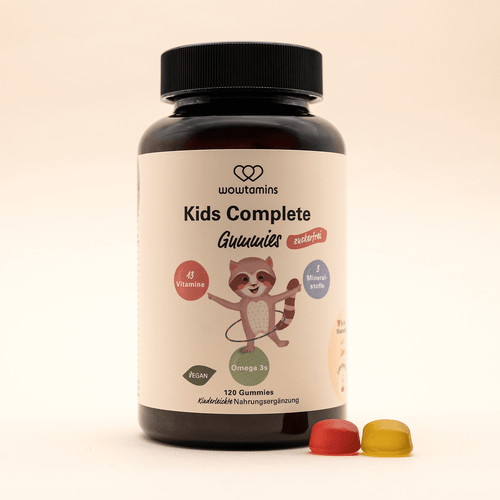Themen dieses Blogartikels:
What is vitamin b3?
Vitamin B3 is a water-soluble vitamin of the B vitamin group and is also called niacin or nicotinamide.
What are the functions of vitamin b3?
Vitamin B3 is another vitamin that is a building block for an important coenzyme. NAD+/NADH (nicotinamide adenine dinucleotide) is a similar cofactor to the aforementioned FAD, which contains riboflavin as a building block. NAD+ contains vitamin B3. Vitamin B3 therefore fulfills important functions in fat, protein and carbohydrate metabolism as well as in energy metabolism in general1. Vitamin B3 is relevant in both fat burning and fatty acid synthesis. Niacin also has an antioxidant effect and is important for the regeneration of tissues such as the skin and nerves.2
What makes vitamin b3 unique?
As a component of NADH, vitamin B3 is involved in many cell reactions. This cofactor is part of fat burning, fat synthesis, alcohol metabolism, carbohydrate breakdown, cholesterol synthesis, the reduction of oxidative stress, nucleotide production for DNA and so on and so forth3. This gives NADH an almost monopolistic position in the cell.
How much vitamin b3 do you need per day?
The recommended niacin intake according to the German Nutrition Society (DGE) is as follows5:
| Age | Niacin mg equivalents*/day male | Niacin mg equivalents*/day female |
| Infants | ||
| 0 to under 4 months | 2 | 2 |
| 4 to under 12 months | 5 | 5 |
| Children and teenagers | ||
| 1 to under 4 years | 8 | 8 |
| 4 to under 7 years | 9 | 9 |
| 7 to under 10 years | 11 | 10 |
| 10 to under 13 years | 13 | 11 |
| 13 to under 15 years | 15 | 13 |
| 15 to under 19 years | 17 | 13 |
| Adults | ||
| 19 to under 25 years | 16 | 13 |
| 25 to under 51 years | 15 | 12 |
| 51 to under 65 years | 15 | 11 |
| 65 years and older | 14 | 11 |
| Pregnant women | ||
| 2nd trimester | 14 | |
| 3rd trimester | 16 | |
| Breastfeeding | 16 |
* 1 mg niacin equivalents = 1 mg niacin = 60 mg tryptophan (The body can produce niacin from the amino acid tryptophan itself.
niacin from the amino acid tryptophan)
When do you need vitamin b3 most?
If you have skin problems, vitamin B3 can support regeneration4. In this case, it makes sense to pay attention to the niacin supply. This vitamin is also particularly important when energy requirements are high so that the cells do not run out of energy and have to fall back on emergency reserves during this time
How does an vitamin b3 deficiency develop and how does it manifest itself?
Nutritional niacin deficiency occurs primarily in countries where people mainly eat maize. This is because the vitamin B3 it contains is bound and therefore cannot be utilized as well6. In this country, it is mostly illnesses such as chronic diarrhea, liver cirrhosis or alcoholism that lead to a deficiency. This is manifested, for example, by digestive disorders and a feeling of physical weakness. An extreme deficiency can cause the disease pellagra: Symptoms include dementia, diarrhea and skin changes. If left untreated, this nutritional disorder leads to death.7
What happens if there is an overdose of vitamin b3?
The Federal Institute for Risk Assessment (BfR) points out that a sufficient supply of niacin is ensured by the usual diet in Germany. An overdose is usually caused by taking certain food supplements or medication. Doses above 30 mg can cause symptoms such as reddening of the skin, a feeling of heat, hives and itching due to the vasodilating effect.8
Which foods are particularly high in vitamin b3?
Fish and meat as well as dairy products and eggs contain a lot of niacin. But nuts, mushrooms, yeast and pulses also contain a good portion of niacin.
This dictionary entry is based on carefully researched sources:
Bibliography & Sources
- fet-ev.eu/niacin/
- apotheken.de/ Diseases/backgroundknowledge/11545-niacin
- gesundheit.gv.at/leben/ernaehrung/vitamin-mineralstoffe/wasserloesliche-vitamin/niacin.html
- deutsche-apotheker-zeitung.de/news/artikel/2022/10/19/niacin-fuer-die-haut-ist-die-effekt-betlich
- dge.de/science/reference values/niacin/
- netdoktor.de/ernaehrung/lebensmittel/vitamin-b3-lebensmittel/
- msdmanuals.com/de-de/profi/ern%C3%a4tion-related-st%C3%d6rungs/vitamin-deficiency,-dependence-and-intoxication/niacin-deficiency
- bfr.bund.de/cm/343/die-einnahme-von-nicotinsaeure-in-ueberhoehter-dosierung-kann-die-gesundheit-schaedigen.pdf


























